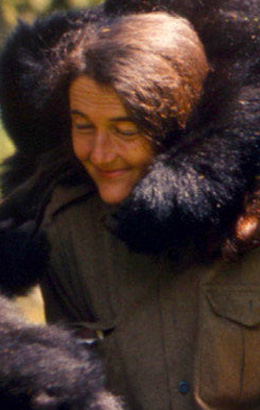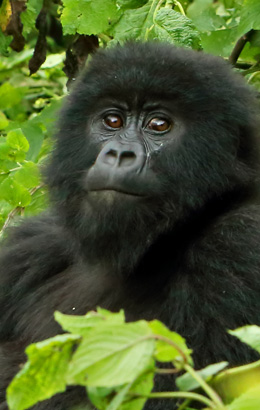“Gorilla conservation shows that humans can right their wrongs”: Director speaks with Down to Earth magazine
Jillian Miller has been the Director of the Gorilla Organization since 1992. In a special interview with Down to Earth magazine, a leading science and nature publication based in India, she talked about the past, present and future of gorilla conservation. Here is the interview in full:
For the benefit of our readers, please explain the various measures carried out by The Gorilla Organization to conserve the Great Apes?
The story of the Gorilla Organization starts with Dian Fossey, the late American primatologist. When she was in Rwanda, the Mountain Gorilla population was down to about 248. Fossey implemented anti-poaching measures. She was murdered in the mid-1980s by suspected poachers for trying to protect and conserve gorillas.
By the time, I came along at the end of the 1980s, the war that ultimately led to the Rwandan Genocide, was already underway. It became apparent that scientific research alone was not enough to save the gorillas and that communities would have to be involved.
Women trained to deliver solar power to their villages
Since the early 1990s, the Gorilla Organization has specialised in working with communities. The idea is if people have a stake in the preservation of an environment, they are more likely to defend it.
We work to raise the standard of living of people who live around Protected Areas (PAs), so that they then defend such areas as well as the species which live in them.
For the last 25-30 years, we have worked with communities on a long-term programme, doing micro-credit, arranging fresh water, and growing food by activities such as beekeeping or organic farming. All this is to alleviate pressure so that people do not have to rely on the resources of the forest in order to meet their daily needs.
When we got involved in solar power, we worked with an organisation in Rajasthan called ‘Barefoot College’, where the Indian government trained rural women from across the world (in our case, Africa) to be solar engineers in their own villages.
That has been our work so far and the results are very good as the Mountain Gorilla population is now above 1,000. We are also discovering newer populations of gorillas in the Congo despite the war there. As far as endangered species conservation goes, it is tentative but it is a success story.
Is the future of gorilla conservation female? If yes, why?
Certainly, there have been some very high-profile women involved in gorilla conservation over the years, not the least of which is Dian Fossey. She was also a role model. Many women went into biological and conservation science because they were inspired by Dian Fossey. So, you find a lot of primatologists and marine biologists who are female.
In a lot of villages that we work in, women are benefiting from our projects, many of which are food-growing. But they are also responsible for educating the children, like everywhere else in the world.
I don’t know whether the future is female because I would not want to be mean to the males as it takes all sorts to make a world. But at the same time, there is a very strong influence from women in protecting endangered species, threatened environments and educating the next generation who are going to care for the planet.
Some organisations like Survival International decry the current model of conservation globally. They say it seeks to protect wildlife at the cost of indigenous peoples. What has been your experience like while working with a group like the Batwa? Do you agree with the view that they have lost the most due to gorilla conservation since now they can’t enter the forests that were once their home and have to adapt to a lifestyle they have never known?
Personally, I feel very strongly about this and have worked for quite a long time to redress that balance. I think the Batwa are very much victims of conservation.
Even as late as the mid-1990s, they were being evicted from their traditional forest homes. And like all indigenous people, when they are evicted from their own land, they have no resources. They become beggars and live in terrible conditions.
We have been working for 20 years with the Batwa. A lot of it involves growing food. For instance, we work with 10 villages in Uganda, where we help them to grow potatoes. People said the Batwa would never farm. But they are getting incomes and the Batwa children are going to school.
My own feeling is that they should have never been evicted from the forest in the first place. But having been evicted, we have worked with them to develop programmes which can provide alternatives.
One was a massive programme in Rwanda, funded by the European Union. Under it, we provided literacy training and bought land, which is very important. If disenfranchised people can have title to land, they can grow food and can lift themselves up from that first level of poverty.

Batwa farmers trained by the Gorilla Organization posing with their new tools
Would you agree with the view that indigenous peoples are the best stewards of wildlife globally?
When we first started this programme, I consulted an indigenous people’s leader in Seattle, Washington in the United States. He showed me a map of the world and said, ‘Look, everywhere in the world, where indigenous people have stayed in the forest, the map stays green and where they are evicted from the forest, the map turns brown’.
So, this idea that indigenous people are the custodians of the forest is a very strong point. To some extent, you can argue that perhaps the gorillas would have been in a lot worse state than they are now if it were not for the fact that the Batwa had been in the forest and had been part of its preservation for so long.
Some conservationists like Mordecai Ogada claim that conservation in Africa is dominated by white westerners. Would you agree?
Historically, it has been. That is for sure. But my organisation in particular has an all-African staff in Africa.
That is because I noticed very early on that as long as you had American or European staff who were driving around in a 4X4 handing out cash and collecting reports, the African staff were not getting invited to the big meetings.
They were banging their heads on a glass ceiling they could not get above. Whereas if you remove that level of administration then the African managers are taken seriously and they can rise. That is what we have championed for a long time. All our staff in Africa are Africans.
While peace has largely returned to Uganda, Rwanda and Burundi, the Democratic Republic of the Congo is still the site of conflict. And now, there is an additional danger, that of Ebola. How do organisations like yours plan to tackle this?
This relates to your previous question. The reason that we have been able to keep our programmes going for 20 years or more in the Congo is because we have African staff.
We have had to evacuate them at times of war. We have had the banks closed down and the money frozen. The staff has had to hide with their children under their beds and not go out of their houses for days on end because there have been bullets flying around.
The war has put them under terrible strain. And yet, when I ask them ‘why do you live here’, they reply: ‘This is the most beautiful place on Earth’. They believe in what they are doing and it is their resilience that has allowed us to continue our projects there.
Now, my real fear is Ebola because it is such a dangerous disease for both, people and gorillas. At the moment, we are trying to work with the aid and medical agencies based there to make sure that people are not coming in and out of the forest and the disease stays contained in the areas where it is most prevalent and does not spread.
A case of Ebola was reported recently in Uganda, across the border from the Congo. Uganda has a very good record of containing infectious disease. They are well-rehearsed. But I have to say it is precarious, dangerous and very worrisome.
Most popular culture representations about gorillas in the West have largely featured Mountain Gorillas. Do you think this is unfair to other subspecies?

The Cross River gorilla: the overlooked ape?
If you are talking about gorillas in entertainment, a lot of them are people in gorilla costumes anyway, so I don’t know if it makes a lot of difference.
As far as documentaries are concerned, I would love to see more of them on Cross River or Western Gorillas. They live in fascinating habitats and there are stories to be told there.
Whether it is unfair or not, I don’t know, since historically the Mountain Gorillas’ home was the first where hi-profile conservation work went on and where access for film crews was easier initially.
Should Great Apes be considered legal persons, given that they are sentient beings? Should they be kept in zoos in the light of incidents like Harambe?
All I can tell you about this is my own personal view. I don’t like to see gorillas in zoos or captivity. I understand the arguments for captive breeding programmes for endangered species. At the same time, animals in zoos become de-natured. I would much rather see them in PAs in the wild.
As far as giving human rights to apes is concerned, I know there is a movement of people who would like to see this. My own feeling is we can’t even guarantee the human rights for humans all over the world yet.
I would like to see animal rights enforced. I would like to campaign for animals to be protected as animals in their natural environment before I can campaign for them to have human rights.
Will future generations of humans be able to see the majesty of Great Apes in the wild given the rate at which we are tearing our planet apart?
I feel quite strongly about this. The idea that we are tearing the planet apart is such a popular concept these days. And yet, when you look into it, we are conserving species and planting forests — my team planted two million trees in the Congo in the last few years and we are a tiny drop in the international effort. Climate change is an emergency but there are initiatives all over the world to mitigate it. People are working very hard to right the wrongs that humans have caused.
One of the success stories is the conservation of mountain gorillas. In Dian Fossey’s day in the 1980s, she thought they would not even survive the 20th century. And here we are, two decades into the 21st and their population is getting stronger all the time. That is because the world and the Rwandan and Ugandan governments had a will and an economic incentive to make sure that endangered species could be protected.
So, from my point of view, I don’t think it is inevitable that future generations are not going to appreciate these animals. I hope they would be able to appreciate them in new ways. Rather than going to zoos, they would see them electronically, in augmented reality and all sorts of things that we don’t even know about yet. I don’t think the future is as bad as people think it is.
Read more wildlife news and features from Down to Earth on the magazine’s website
















